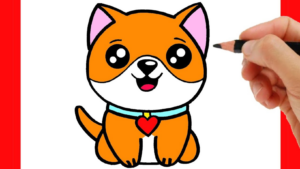Welcome to the charming world of “Kawaii”, a term that’s become a global phenomenon. It’s a Japanese word that translates to “cute”, and it’s a significant part of Japanese culture. Kawaii isn’t just about adorable characters and designs; it’s a way of life that can be seen in everything from fashion to food, to art.
In the realm of art, Kawaii has a unique place. It’s often expressed through “dibujos para dibujar” or drawings to draw. These aren’t your average sketches. They’re filled with vibrant colors, exaggerated features, and a distinct sense of whimsy. Whether you’re an artist looking to revolutionizing tech art or a Kawaii enthusiast, there’s a lot to explore and appreciate. So, let’s delve into the captivating world of Kawaii drawings, and discover why they’ve captured hearts worldwide.
Kawaii:zymdychsile= Dibujos Para Dibujar

Embarking on an exploration of Kawaii Dibujos Para Dibujar presents an opportunity to delve deeper into the captivating universe of Kawaii culture, and its significant impact on modern art. It can also help you enhance efficiency in your everyday life.
In the 1970s, Japan witnessed the birth of Kawaii Culture. High school girls, in particular, started to alter the forms of their writings into rounded, simple styles, akin to childlike scribbles. This shift sparked a new linguistic trend commonly known as ‘Anomalous Female Teenage Handwriting’. The style resonated with the cultural shifts of the time, enhancing the growing influence of consumerism and pop culture which facilitated the rise of Kawaii culture.
A prominent example is Sanrio’s Hello Kitty, a fictional character that debuted in 1974 and quickly became a beacon of Kawaii Culture. The character’s simplicity, with its minimalist design, parallels the simplicity sought in Kawaii culture. Over the years, the big-eyed, pink-bowed cat became a cultural icon and laid the ground for other Kawaii characters.
The Role of Kawaii in Modern Art

Kawaii’s influence permeates various sectors of the modern art scene, from illustration to graphic design and fine art. It’s not just about creating cute characters but also about challenging the conventional norms and inviting viewers to interpret different elements in their own personal contexts.
Dibujos para dibujar, a significant facet of Kawaii culture, illustrates this point aptly. These drawings, characterized by their vibrant colors and exaggerated features, lean towards a whimsical, playful style. They provide artists with an avenue to explore various themes, ideas, and expressions within a Kawaii framework. This serves to disrupt the more austere aura often associated with traditional art, creating space for more light-hearted and approachable pieces that resonate with a broader audience.
Key Features of Kawaii Style

Deepening the understanding of Kawaii art, this section delves into the notable characteristics that define this unique style, cómo los dibujos Kawaii difieren del arte tradicional.
Kawaii artwork stands apart, embracing a notion of cuteness that transcends cultural boundaries. First, the defining characteristic of Kawaii art is the exaggerated features. Eyes, for instance, are often large and sparkling, giving life to the subjects. Secondly, the usage of vibrant colors cannot be overstated. Kawaii illustrations thrive on a palette of bright, cheerful hues that strike an emotional chord. The third characteristic is the whimsical style, which draws in viewers with its playful charm and simplicity. For example, Hello Kitty and Pokémon—icons of Kawaii art—boast simple lines and a delightful aura. Lastly, Kawaii art often features subjects imbued with a sense of innocence and cheerfulness, reinforcing its allure.
Comparing Kawaii art with traditional art forms, the differences are stark. Traditional art tends to adhere to realistic proportions and somber tones, following strict standards developed over centuries. Kawaii art, however, tosses these conventions aside. Focusing on exaggerated forms, it promotes exaggerated features, such as oversized eyes and heads.

